Qualcomm Snapdragon S4 (Krait) Performance Preview - 1.5 GHz MSM8960 MDP and Adreno 225 Benchmarks
by Brian Klug & Anand Lal Shimpi on February 21, 2012 3:01 AM EST- Posted in
- Smartphones
- Snapdragon
- Qualcomm
- Adreno
- Krait
- Mobile
We won't go too deep into Krait's CPU architecture, because we've already done so in an earlier piece. What we can provide however is a quick recap. Architecturally Krait isn't a design of tradeoffs, rather it's a significant step forward along almost all vectors. Each core can fetch, decode and execute more instructions in parallel than its predecessor (Scorpion, Snapdragon S1/S2/S3).
| Qualcomm Architecture Comparison | ||||
| Scorpion | Krait | |||
| Pipeline Depth | 10 stages | 11 stages | ||
| Decode | 2-wide | 3-wide | ||
| Issue Width | 3-wide? | 4-wide | ||
| Execution Ports | 3 | 7 | ||
| L2 Cache (dual-core) | 512KB | 1MB | ||
| Core Configurations | 1, 2 | 1, 2, 4 | ||
Even if you're not comparing to Qualcomm's previous architecture, Krait maintains the same low level advantage over any other ARM Cortex A9 based design (NVIDIA Tegra 2/3, TI OMAP 4, Apple A5). Clock speeds are up with only a small increase in pipeline depth. The combination of these two factors alone should result in significant performance improvements for even single threaded applications. If you want to abstract by one more level: Krait will be faster regardless of application, regardless of usage model. You're looking at a generational gap in architecture here, not simply a clock bump.
| Architecture Comparison | ||||||||
| ARM11 | ARM Cortex A8 | ARM Cortex A9 | Qualcomm Scorpion | Qualcomm Krait | ||||
| Decode | single-issue | 2-wide | 2-wide | 2-wide | 3-wide | |||
| Pipeline Depth | 8 stages | 13 stages | 8 stages | 10 stages | 11 stages | |||
| Out of Order Execution | N | N | Y | Partial | Y | |||
| FPU | VFP11 (pipelined) | VFPv3 (not-pipelined) | Optional VFPv3 (pipelined) | VFPv3 (pipelined) | VFPv4 (pipelined) | |||
| NEON | N/A | Y (64-bit wide) | Optional MPE (64-bit wide) | Y (128-bit wide) | Y (128-bit wide) | |||
| Process Technology | 90nm | 65nm/45nm | 40nm | 40nm | 28nm | |||
| Typical Clock Speeds | 412MHz | 600MHz/1GHz | 1.2GHz | 1GHz | 1.5GHz | |||
The memory interface of the chip has been improved tremendously. At a high level, the MSM8960 is Qualcomm's first SoC to feature PoP support for two LPDDR2 memory channels. We suspect there are lower level improvements to the memory interface as well however we don't have more details from Qualcomm, not to mention the current state of memory latency/bandwidth testing on Android is pretty abysmal.
Quantifying the Krait performance advantage requires a mixture of synthetic and application level tests. We'll start with Linpack, a Java port of the classic memory bandwidth/FPU test:
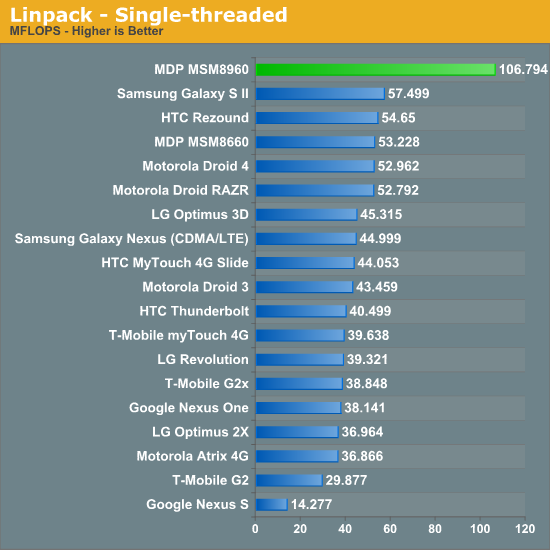
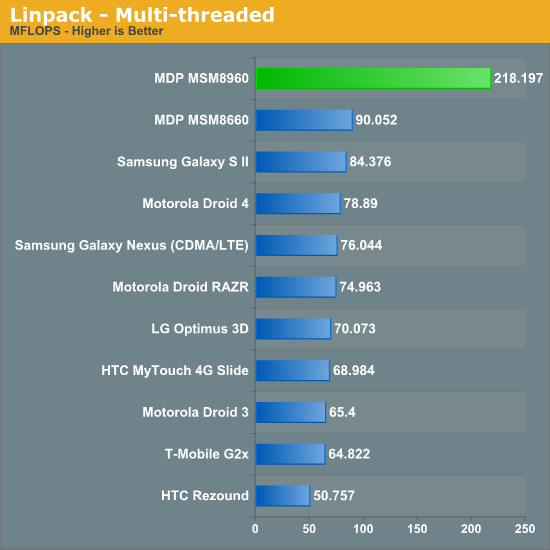
Occasionally we'll see performance numbers that just make us laugh at their absurdity. Krait's Linpack performance is no exception. The performance advantage here is insane. The MSM8960 is able to deliver more than twice the performance of any currently shipping SoC. The gains are likely due in no small part to improvements in Krait's cache/memory controller. Krait can also issue multi-issue FP instructions, A9 class architectures can apparenty only dual-issue integer instructions.
Moving on we have our standard JavaScript benchmarks: Sunspider and Browsermark. Both of these tests show significant performance improvements, although understandably not by the margins we saw above in Linpack:
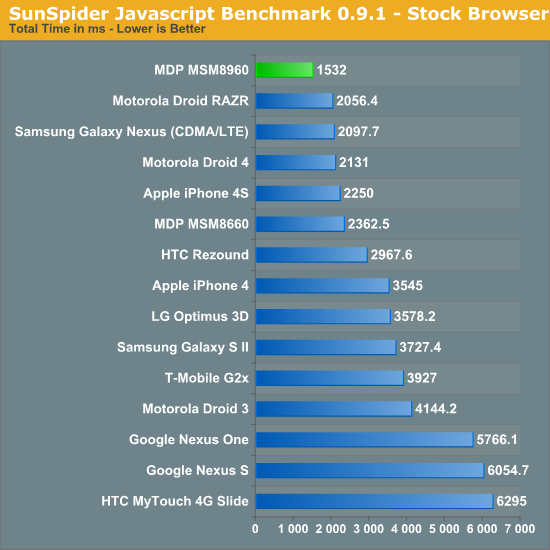
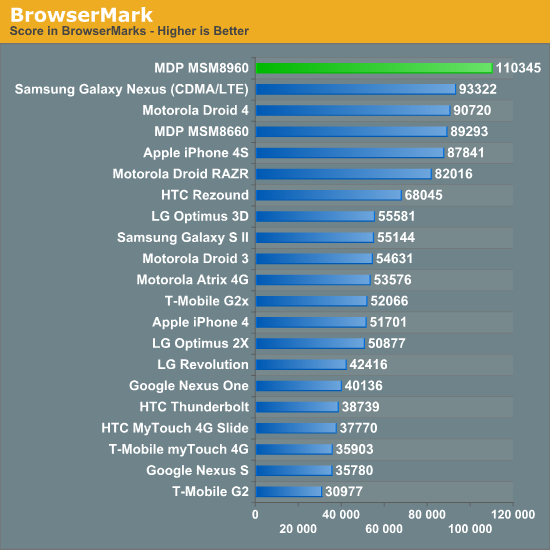
Krait and the MSM8960 are 20 - 35% faster than the dual-core Cortex A9s used in Samsung's Galaxy Nexus. For a look at how overall web page loading is impacted we loaded AnandTech.com three times and averaged the results. We presented results with the browser cache cleared after each run as well as results after all assets were cached:
| AnandTech.com Page Loading Comparison (Stock ICS Browser) | ||||
| Browser Cache Cleared | Cache In Use | |||
| Qualcomm MDP MSM8960 (Krait) | 5.5 seconds | 3.0 seconds | ||
| Samsung Galaxy Nexus (ARM Cortex A9) | 5.8 seconds | 4.4 seconds | ||
There's hardly any advantage when you're network bound, which is to be expected. However whenever the device can pull assets from a local cache (something that is quite common as images, CSS and even many page elements remain static between loads) the advantage grows considerably. Here we're seeing a 46% advantage from Krait over the Cortex A9 in the Galaxy Nexus.
We turn to Qualcomm's own Vellamo as a system/CPU/browser performance test:
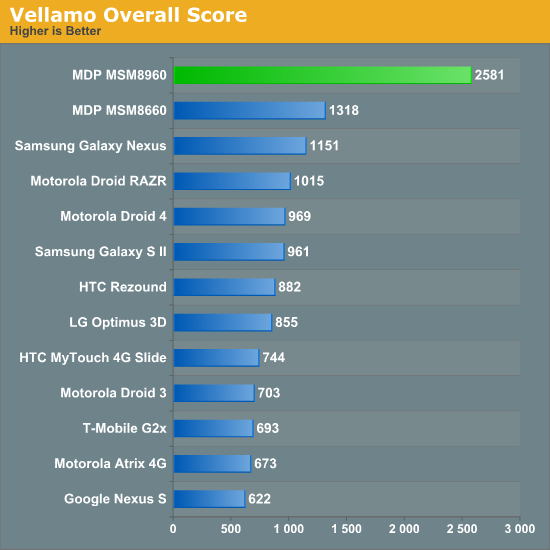
Again, we're showing a huge performance advantage here thanks to Krait. Seeing as how Vellamo is a Qualcomm benchmark don't get too attached to the advantage here, but it does echo some of what we've seen earlier.
Finally we have Rightware's Basemark OS 1.1 RC which is fast becomming an impressively polished system benchmark, one which will hopefully eventually take the place of the likes of Quadrant.
| Basemark OS - System | |||
| HTC Rezound | Galaxy Nexus | MDP MSM8960 | |
| System Overall Score | 658 | 538 | 907 |
| Simple Java 1 | 298 loops/s | 210 loops/s | 375 loops/s |
| Simple Java 2 | 7.28 loops/s | 8.61 loops/s | 10.8 loops/s |
| SMP Test | 35.3 loops/s | 49.2 loops/s | 64.4 loops/s |
| 100K File (eMMC->SD) | 6.49 mB/s | 9.52 mB/s | 8.64 mB/s |
| 100K File (SD->eMMC) | 33.0 mB/s | 17.8 mB/s | 39.8 mB/s |
| 100K File (eMMC->eMMC) | 37.8 mB/s | 34.5 mB/s | 48.9 mB/s |
| 100K File (SD->SD) | 8.47 mB/s | 8.30 mB/s | 12.7 mB/s |
| Database Operation | 10.0 ops/s | 5.73 ops/s | 19.4 ops/s |
| Zip Compression | 0.509 s | 0.848 s | 0.561 s |
| Zip Decompression | 0.097 s | 0.206 s | 0.073 s |
On the CPU centric tests Basemark OS is showing anywhere from a 20% - 80% increase in performance over the 1.5 GHz APQ8060 based HTC Rezound. IO performance is also tangibly improved although that could be a function of NAND performance rather than the SoC specifically.
These results as a whole simply quantify what we've felt during our use of the MSM8960 MDP: this is the absolute smoothest we've ever seen Ice Cream Sandwich run.










86 Comments
View All Comments
metafor - Tuesday, February 21, 2012 - link
It's Sense. If you look at some of the phones with a less bloated version of Android (like the Xiaomi phone used in the Vellamo benchmark article that runs the same processor as the Rezound but with MIUI), they score pretty close to the MDP scores.Wishmaster89 - Tuesday, February 21, 2012 - link
That is why I will never buy device that bares the mark 'with HTC Sense'.They went one step too far with their customisations when they impacted performance of the device.
monoik - Tuesday, February 21, 2012 - link
Did you make your tests on Gingerbread SGS2? I'm getting very different results on Ice Cream Sandwich Cyanogen Alpha:For worse:
Linpack single 47.257 MFLOPS
Linpack multi 71.987 MFLOPS
For better:
BrowserMark 105937
Vellamo 1596
SunSpider-0.9.1 1762.2ms
non-cached anandtech.com about 4,5 seconds from touching "go" to the progressbar disappearing.
cached anandtech.com less than 2 seconds.
Stock browser. No overclocking. GT-I9100 Exynos version.
Kaboose - Tuesday, February 21, 2012 - link
I am going to assume the latest OFFICIAL OS released by samsung Anandtech is not in the business of benchmarking every different ROM or OS on every phone. You would most probably be getting different results running ICS Cyanogen. As far as I know ICS is only official on the Nexus.monoik - Tuesday, February 21, 2012 - link
I assume you're right, so we're comparing apples and oranges here. No real value there, don't you think?rahvin - Tuesday, February 21, 2012 - link
Cyanogen is typically crippled by the fact that they are restricted to the open source versions. Especially in early release they don't have access to many of the customizations and binary code in release versions let alone per-release.It's my experience that Cyanogen doesn't even come close to release performance or power use until about a year later. This is because it takes the manufacturers about 6 months to post their kernel source then another 6 months to port and modify for the cyanogen system.
So comparing a cyanogen alpha mod to a developer preview isn't even relevant, as was said.
tomhoward - Tuesday, February 21, 2012 - link
There original SGS2 results were incorrect in the S2 vs 4S post a while back. There was a pretty big flame war in the comments from people with stock phones getting around 2000ms in Sunspider but Anandtech just ignored them.B3an - Tuesday, February 21, 2012 - link
@Brain or Anand...Do you think that Win 8 tablets using ARM SoC's will likely have a SoC based on many of the components inside Krait? I know there will have be certain changes for WOA but the CPU and possibly the GPU (now that it supports Direct3D 9_3) will be used for these tablets?
And the same goes for ARM's A15, will WOA likely be running on SoC's based on that too?
kyuu - Tuesday, February 21, 2012 - link
If I can get this SoC in a Lumia-ish Windows 8 phone with a decent screen and removable micro-SD storage, whoever makes that phone will have my money.kyuu - Tuesday, February 21, 2012 - link
I mean Windows *Phone* 8 phone, of course.